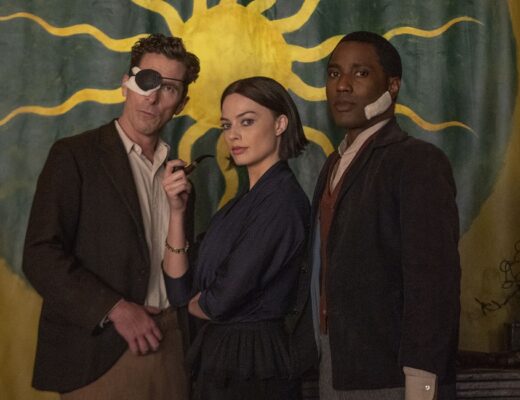Raya and the Last Dragon is beautifully animated and welcomingly eccentric, but also a little overly familiar.
Much remains the same in Disney’s latest animated project, Raya and the Last Dragon. In the film, the studio continues their recent trend toward warrior women — here, in its most literal application since Mulan — with a character, the eponymous princess, who is an expert in martial arts and swordplay and who spends the majority of her time in the company of an oddball fantasy critter: specifically, Tuk Tuk, a creature described by the filmmakers as an amalgam of a pill bug, an armadillo, and a pug. The film’s story construction likewise hits the familiar beats: there’s some framework mythology explaining the central conflict, an out-of-whack elemental force in the metaphorical form of a relic that needs first found and then fixed, and, of course, the resultant happy ending — typical fable fare. In fact, it perhaps shouldn’t surprise that Raya and the Last Dragon is directed by Don Hall, credited as a co-director on Moana, the closest touchstone for this latest. Instead of a girl and a demigod, there is a girl, Raya (Kelly Marie Tran), and a dragon, Sisu (Awkwafina); rather than Te Fiti’s heart, it’s the shards of a magical orb that can bring peace; and in place of a Mother Earth analog wreaking havoc, it’s the Druun — a monstrous force similar in appearance to the Smoke Monster from Lost which represents human discord in the world and turns people to stone — that poses an existential threat.
Also present in Raya is the Mouse House’s inclination for hopeful and reductive moralizing, a de facto element of any Disney kids’ film, but one which here, in 2021, is particularly tone-deaf with its message that no human is beyond redemption if we can all just come together and learn to forgive. Assuming viewers can stomach such status quo idiocy and indeed, well, forgive a cartoon for such inane rhetoric, there’s actually plenty to like. The flip-side of Disney’s blanket idealism is a recent push for more representation in their output, an important shift but one which requires delicacy. Hall trades in Moana’s Polynesian mythology for that of Southeast Asia, historically underrepresented to Western audiences in the face of China and Japan’s (and, to a degree, South Korea’s) cinematic presence, but there’s no real historical parallel or weight here, other than what’s implicit in the act of representation. In fact, Raya and the Last Dragon seems to draw from a broad spate of Asian cinema. The five-color panel of Zhang Yimou’s Hero is clearly present in the vying factions here, and there’s more than a little Miyazaki: the animators take delight in their creature creations, food is a prime compositional and narrative fixture, and there’s an evident contrast between high cartoon (the fluidity of the dragons) and more gritty realism (a few impressively rendered and highly kinetic fight sequences). The filmmakers draw on such inspirations innocently enough, imbuing the film with a little flavor given the purely aesthetic utility of such choices; less innocuous is the studio’s decision to cast voice actors of varying Asian backgrounds, leaving room for only a handful of SEA performers in the process.
That blemish aside, Disney films of this particular spirit largely thrive or fail according to their visceral pleasures — chart-topping musical numbers, memorable and wacky characters, visual playfulness and age-defying sight gags — and it’s here that Raya and the Last Dragon finds most purchase. Immediately distinctive is that while existing firmly in Disney fabulist territory, unlike recent (largely) song-free, tech-centric efforts like Wreck-It Ralph and Big Hero 6, it’s not a musical. Everything about the film’s myth-heavy shape and progressive assemblage of kooky characters invokes Disney muscle memory and suggests a tune is just around the corner, but the film’s impressive visual design is ultimately where most attention is paid. While the human renderings can at times look a bit like imprecise 3D cartoon bobbles, the surrounding texture is full of personality and detail. Raya is certainly Disney’s most colorful work in a minute, a starburst of pastels and neons, saturating and enlivening the core quest. The aforementioned fight sequences are particularly impressive, taking care to throw in artificial camera tilts and oblique angles to frame the fluid action, even drilling down to the point of representing different fighting styles (one scene clearly begins with the two combatants respectively taking Muay Thai and Pencak Silat stances). Meanwhile, the plentiful secondary characters — including a tween orphan shrimper-cum-restauranteur, a waddling baby con artist, and a rival factioner who garbles his words and speaks in a style one might call brute poetics (voiced by Benedict Wong, absolutely balling out) — are a legitimate hoot and reflect an unhinged nonsensicality often absent in Disney’s carefully-calculated films. And really, those are the reasons viewers are here. Despite its unique setting, there’s not a lot that’s original in Raya and the Last Dragon, but there’s enough aplomb, both in its striking visual palette and sneaky eccentricity, to situate it as part of Disney’s current animation plateau. It’s neither much of a step forward or back in terms of overall quality or ambition, but the filmmakers manage to finesse enough small pleasures from the familiar.
You can view Don Hall’s Raya and the Dragon in theaters or streaming on Disney+ beginning on March 5.







